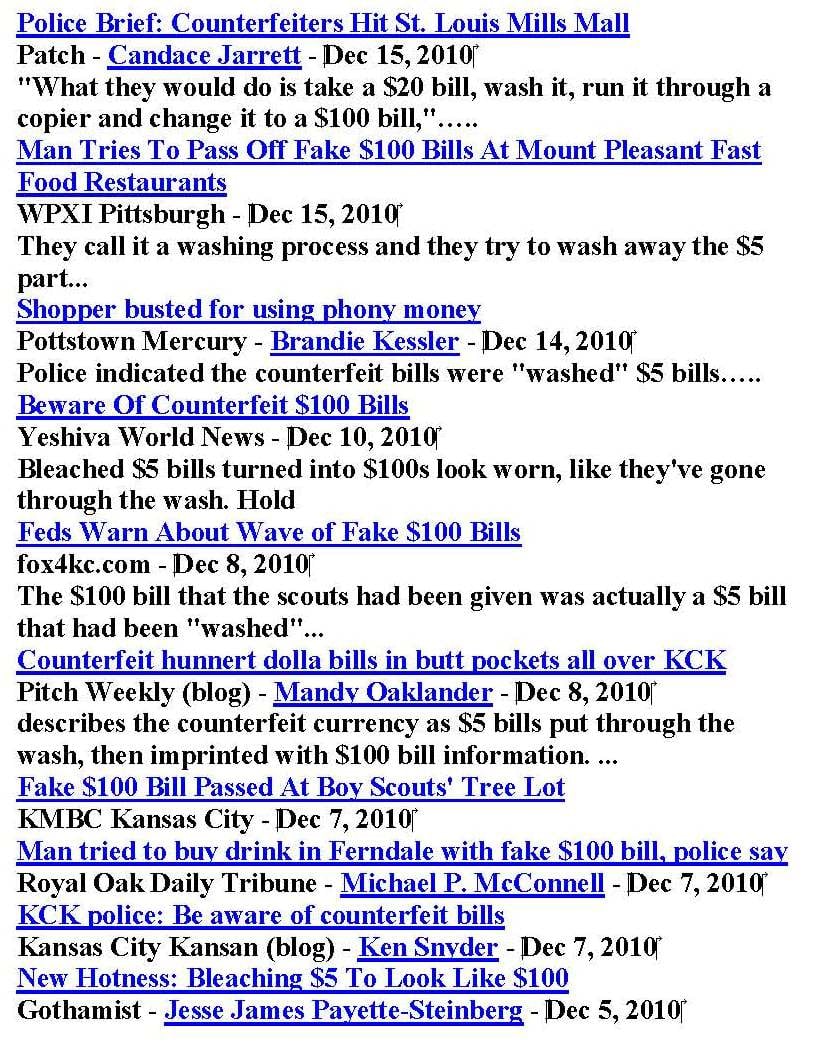A few days ago, I typed the words “Washed $100 Bill” into Google News, and below is the first page of results. There were counterfeit money stories in newspapers and other publications from all around the U.S. In fact, in December, alone, through 16 days, there were 37 separate news stories on the topic featuring the words “wash” and “$100”.

Washing $5 bills and reprinting them into $100’s is a trend expanding at exponential rates. The primary benefit for the bad-guy is that the reprinted counterfeit notes will pass the “counterfeit pen” test. “The pen is used to detect iodine or starch,” says Todd Madison of the US Secret Service. “So it won’t help with bleached notes.” The pens don’t work because the counterfeit bills are printed on genuine US banknote paper.
The washed notes will also have both a security thread and a watermark in it – although neither feature will be correct for the $100 bill. The typical “eye-ball” review of these features will not be able to detect this fact. Particularly adept counterfeiters can wash the $5 bill without damaging the magnetic ink, thus, even counterfeit detectors looking for magnetic features my falsely identify these fake $100 bills as genuine.
Although this bleaching technique has been a relatively common process for years, it is only recently – as recent as February of this year - that law enforcement begun uncovering links to international organized crime. By putting professional manufacturing techniques and large scale production facilities into action, groups in Peru and Slovakia have been taking “washed bills” to a new level. They apply Six-Sigma quality control to the documents and are able to learn, revise and improve their “product” as they run through successive iterations, utilizing customer feedback to overcome issues with the counterfeit currency.
The Secret Service says if you get one of these bills, it is illegal to pass it along to the next guy. Instead, you should call your local law enforcement agency as soon as possible. Roughly translated – you get stuck with the loss, regardless of how you got the counterfeit note. One famous case in Los Angeles involved an unsuspecting customer receiving 8 washed $100 notes from a Post Office branch. The poor fellow was unable to recoup his loss, since there was no way to prove that he had received the notes from the USPS.
The “good news” is that, properly equipped, it is not too difficult to detect washed notes. The use of washed notes in the public is based on the assumption that close scrutiny with professional authentication tools will not be performed. If a business is willing to make a small investment, then they can protect themselves from not only washed notes, but the full array of counterfeit currency techniques – digital copies, washed bills, raised notes and even off-set production counterfeits.
UV counterfeit detection units are capable of identifying washed notes. Ultraviolet detectors will cause the $5 security thread embedded inside the paper of the washed note to glow blue. This is an instant and easy-to-see indicator that the $100 bill is fake, because the genuine security thread in a $100 bill should appear as a very pale pink color, NOT blue.Click here for a limited time 20% discount on the best selling UV detector in the US
This is an instant and easy-to-see indicator that the $100 bill is fake, because the genuine security thread in a $100 bill should appear as a very pale pink color, NOT blue.Click here for a limited time 20% discount on the best selling UV detector in the US
More advanced electronic bill verifier units, such as the CT-550, will also identify these notes as fake. These advanced readers analyze the banknote under various wavelengths of light and different levels of magnification. Through this process, the CT550 actually reads and verifies a number of different “covert” security features in combination, including the image itself, infra-red features, magnetic features, ultra-violet features, bill size (which differs slightly from denomination to denomination) and several other factors. Running these data points against its advanced algorithm, these devices identify exactly what it sees and notifies the user if the note is not able to be identified as genuine currency.


